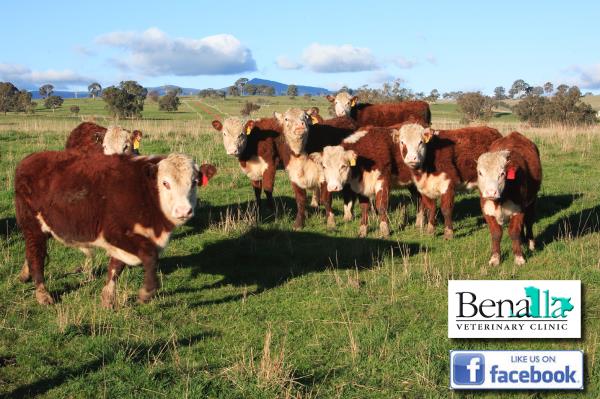Common Cattle Diseases
at Benalla Veterinary Clinic
Common Cattle Diseases
1. Grass Tetany
Grass tetany is a highly fatal disease of all classes of ruminants. Typically the first indications of grass tetany are a sudden onset of anxiety, muscle tremors, and an extreme sensitivity to touch or sudden noises. Many of these animals are found down in the paddock unable to rise, or dead. Subclinical cases are much harder to detect and may simply present as ill-thrifty animals with a slight tremor and/or depressed milk yield.

There are many risk factors which can contribute to the occurrence of grass tetany, such as:
- grass dominant pastures, especially cool season grasses which are most hazardous due to their low magnesium content, or when broadleaf weeds are sprayed out and grasses dominate
- early growing season, especially during rapid growth after cold, wet weather
- local soil types
- excessive use of potassium based fertilisers (potassium competes with magnesium for absorption)
- partial starvation, eg. unpalatable feeds
- cold, wet, windy weather
- any form of stress when magnesium levels are lower than normal. Stress from cold, wet weather, mustering, yarding, trucking, starvation and being on heat can bring grass tetany on.
- scours (feed moves through the gut too quickly for the magnesium to be absorbed adequately)
- older cows with young calves are most susceptible
Importantly, one or two clinical cases are often indicative of a widespread magnesium deficiency in the herd. Blood testing susceptible herds is recommended.
Treatment is based around replacing the magnesium to re-establish a normal balance. Plastic pouches of magnesium sulphate solution and 4in1 are available and are useful therapies. These may be given subcutaneously (under the skin), or into a vein (preferably by a veterinarian) – extreme care must be taken as intravenous treatment can lead to a lethal overdose. Too much given too quickly is likely to lead to serious and potentially fatal cardiac and respiratory irregularities. In the vein treatments are generally considered a veterinary procedure because of this risk of death.
Prevention – can be achieved by one of the following supplementation methods.
Dietary supplementation of magnesium at a daily rate of at least 60g of magnesium/head/day can be achieved by:
- mixing with hay is most effective method – either poured as a slurry into hay, sprayed on or mixed as powder – e.g. Causmag (MgO) sprayed onto hay @ 0.25kg per 25kg bale with or without the addition of 2% molasses
- Causmag-treated grain, ie 35kg Oats, 6kg Causmag, 2L water, 3kg Molasses will supplement 100 cows for 1 day
- Drenching – although labour intensive
- magnesium ‘bullets’ which gradually dissolve in the stomach over a period of about 3 months
- pasture top-dressed with magnesium rich fertilisers
- supplementation in drinking water – Epsom salts (MgCl) at 3g/L Only useful where surface water is not available to stock
- mineral blocks/’salt licks’ – depending upon the block often requires 1 block/10cattle/9days.
The class of animals affected and local knowledge will aid in choosing the most suitable treatment – if you have any queries simply contact us here at the clinic. It can take 2 – 3 days before stock are protected.
Additional control measures include avoiding short periods of starvation and stressful procedures, restricting use of high potassium (K) fertilisers in problem areas and providing shelter and supplements in cold, wet, windy conditions. Also avoid moving cattle in the last 6 weeks of pregnancy.
Remember – Adult cattle are not the only stock that may be affected
CALVES- usually occurs in calves 2-4 months of age that are fed exclusively on whole milk. The presence of scours can also increase incidence. Clinical signs are similar to that of adults however this disease is far less common.
SHEEP- recorded in any class of sheep, particularly wethers on young, green cereal crops or good milking ewes raising fat lambs. Clinically they look similar to Phalaris grass staggers. Prevention involves supplementation of about 7g magnesium/day as described for cattle.
More information articles to follow (under development)
2. Ketosis
3. Fatty Liver Syndrome
4. Milk Fever

Book an Appointment with Us
We ask that you make an appointment if your animal requires veterinary attention. This ensures you will have fast and efficient service. This can now also be done online via our portal.
Proudly serving the pets of Benalla, Wangaratta, Euroa, Winton, Mansfield, Violet Town, Glenrowan, and the surrounding area.
